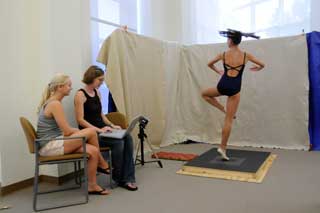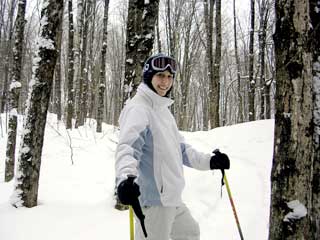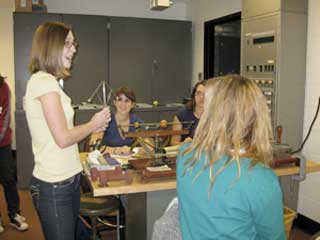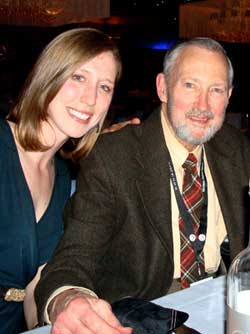Melanie Lott

A dancer performing a pirouette on the force platform, while Melanie watches the data on her laptop.
Photo credit: Pierce Bounds, Dickinson College

Melanie Lott snowshoeing in Vermont
Photo Credit: Gregory Lott

Teaching in the introductory physics lab at Bryn Mawr.
Photo credit: Louisa Wilson
When the Christmas season approaches many people flock to the ballet to watch "The Nutcracker." The audience sits in awe as dancers gracefully move across the stage, toes pointed as they twirl and effortlessly jump into the air landing as if cushioned by a cloud. Though it may look effortless, any dancer will tell you that ballet is not as easy as it seems. One dancer and physicist has set out to explain how dancers maintain their balance while doing one of the most common movements in dance, the pirouette.
Melanie Lott was a shy child. One of her teachers told her mother once in a parent teacher conference that she "was afraid to try new things." Now Lott says, "I love to try new things." She includes on her laundry list of interests sewing, running, hiking, triathlons and especially dancing. She was a dancer for over 12 years and was interested in all different kinds. She said tap is her favorite, but she rarely has a chance to take classes anymore, except occasionally between her studies.
Her love for the human body and its ability to create active art followed her in her academic career. Lott originally attended Denison University in Ohio and studied physics, but her love for dance never left her. One day in Lott's junior year at Denison, while in the library she found a book by Kenneth Laws entitled Physics and the Art of Dance. What to most may seem like a typical moment in school was nothing of the sort to her. "It was one of those moments where you knew; hey, this is what I want to do," she said, describing that turning point in her life. While working on her senior research about the physics of movements in dance and track and field, Lott contacted Laws to thank him for writing his book and to ask if he had any advice for her project. She said, "He emailed me back with the kindest response and also asked if I would share my final research paper with him when I was finished. After I graduated and he read my senior thesis, he asked if I would be interested in coming to Dickinson to do physics of dance research with him. I jumped at the chance!" They worked together for a year to do an experiment to "indirectly measure the force that a dancer's patellar ligament endures when landing from vertical leaps. The patellar ligament connects the patella (kneecap) to the tibia (lower leg bone)," according to Lott. It was after her year at Dickinson that she went to Michigan to pursue her master's in kinesiology, the study of how the body moves. Armed with her background in physics and her focus on the physics of human movement this seemed like a logical transition to help her further understand the physics of dance.
After completing her masters in kinesiology, Lott taught physics for two years, which she found to be a difficult undertaking. "I was young, 24, and I was teaching high school seniors who weren’t much younger than me," she said. After completing two years of teaching she decided her teaching skills would be better suited for a college classroom where she could continue to do her research. She describes this decision by saying, "I think the main reason I decided to go back to graduate school was that I missed the research. I do love teaching too, but I felt that I really wanted to have a career where I could focus on both."
After graduation from Michigan she was accepted to a PhD program at Bryn Mawr to study under Kenneth Laws himself, the very person whose book had led her to study the physics of dance. For her research there, she began by working with Laws, to "make modifications and improve" a platform that measures forces and torques when someone does a pirouette. She now uses this data to analyze dancers’ movements and collect information on how they either achieve a successful pirouette or use one of a number of lightning quick fixes that the untrained eye would miss. Her research not only applies to dancers’ moves, but to any sports or human motions that rely on balancing the center of mass over a support.

Kenneth Laws and Melanie Lott at a conference in Monte Carlo, Monaco.
Photo Credit: Boni Rietveld
When she was asked what she's found so far, she responded with a slight giggle. "Most dancers are sneaky. They slide or hop their foot more than we were expecting," She said. Lott and Laws originally expected to find that when most dancers were falling out of balance in a pirouette they would compensate by accelerating their center of mass back over their supporting foot to regain balance. Surprisingly, according to Lott, "lots and lots of them are sliding their foot around when they do their pirouette."
Even though her research revealed something different than her original hypothesis, Lott continues to study dancer's movements to scientifically define what makes a perfect pirouette.
In addition, Lott also works as a teaching assistant at Bryn Mawr, helping out in the physics labs teaching a variety of subjects including Introduction to Physics, Electronics and Modern Physics Labs. She has taught every semester since arriving at Bryn Mawr, three years ago. Lott found teaching at a liberal arts college very unlike her experience teaching high school students. "I really enjoy getting to interact with the students and having the opportunity to teach as well as to do research. It is also nice because ultimately I would like to be a professor at a liberal arts college, teaching and doing research," Lott said.
Melanie Lott has successfully merged two disciplines, art and science, by observing an art form and explaining its beauty using science. "The physics of dance is way outside the box," Lott said and she is one scientist who didn’t compromise her passions for her studies. "Follow your passion and don’t be afraid to try something outside the box." Lott lives her life by her own advice.











